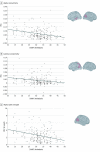Cortical Connectivity Moderators of Antidepressant vs Placebo Treatment Response in Major Depressive Disorder: Secondary Analysis of a Randomized Clinical Trial
- PMID: 31895437
- PMCID: PMC6990859
- DOI: 10.1001/jamapsychiatry.2019.3867
Cortical Connectivity Moderators of Antidepressant vs Placebo Treatment Response in Major Depressive Disorder: Secondary Analysis of a Randomized Clinical Trial
Abstract
Importance: Despite the widespread awareness of functional magnetic resonance imaging findings suggesting a role for cortical connectivity networks in treatment selection for major depressive disorder, its clinical utility remains limited. Recent methodological advances have revealed functional magnetic resonance imaging-like connectivity networks using electroencephalography (EEG), a tool more easily implemented in clinical practice.
Objective: To determine whether EEG connectivity could reveal neural moderators of antidepressant treatment.
Design, setting, and participants: In this nonprespecified secondary analysis, data were analyzed from the Establishing Moderators and Biosignatures of Antidepressant Response in Clinic Care study, a placebo-controlled, double-blinded randomized clinical trial. Recruitment began July 29, 2011, and was completed December 15, 2015. A random sample of 221 outpatients with depression aged 18 to 65 years who were not taking medication for depression was recruited and assessed at 4 clinical sites. Analysis was performed on an intent-to-treat basis. Statistical analysis was performed from November 16, 2018, to May 23, 2019.
Interventions: Patients received either the selective serotonin reuptake inhibitor sertraline hydrochloride or placebo for 8 weeks.
Main outcomes and measures: Electroencephalographic orthogonalized power envelope connectivity analyses were applied to resting-state EEG data. Intent-to-treat prediction linear mixed models were used to determine which pretreatment connectivity patterns were associated with response to sertraline vs placebo. The primary clinical outcome was the total score on the 17-item Hamilton Rating Scale for Depression, administered at each study visit.
Results: Of the participants recruited, 9 withdrew after first dose owing to reported adverse effects, and 221 participants (150 women; mean [SD] age, 37.8 [12.7] years) underwent EEG recordings and had high-quality pretreatment EEG data. After correction for multiple comparisons, connectome-wide analyses revealed moderation by connections within and between widespread cortical regions-most prominently parietal-for both the antidepressant and placebo groups. Greater alpha-band and lower gamma-band connectivity predicted better placebo outcomes and worse antidepressant outcomes. Lower connectivity levels in these moderating connections were associated with higher levels of anhedonia. Connectivity features that moderate treatment response differentially by treatment group were distinct from connectivity features that change from baseline to 1 week into treatment. The group mean (SD) score on the 17-item Hamilton Rating Scale for Depression was 18.35 (4.58) at baseline and 26.14 (30.37) across all time points.
Conclusions and relevance: These findings establish the utility of EEG-based network functional connectivity analyses for differentiating between responses to an antidepressant vs placebo. A role emerged for parietal cortical regions in predicting placebo outcome. From a treatment perspective, capitalizing on the therapeutic components leading to placebo response differentially from antidepressant response should provide an alternative direction toward establishing a placebo signature in clinical trials, thereby enhancing the signal detection in randomized clinical trials.
Trial registration: ClinicalTrials.gov identifier: NCT01407094.
Conflict of interest statement
Figures




Comment in
-
Electroencephalographic Biomarkers for Predicting Antidepressant Response: New Methods, Old Questions.JAMA Psychiatry. 2020 Apr 1;77(4):347-348. doi: 10.1001/jamapsychiatry.2019.3749. JAMA Psychiatry. 2020. PMID: 31895448 No abstract available.
References
-
- Cipriani A, Furukawa TA, Salanti G, et al. . Comparative efficacy and acceptability of 21 antidepressant drugs for the acute treatment of adults with major depressive disorder: a systematic review and network meta-analysis. Lancet. 2018;391(10128):1357-1366. doi:10.1016/S0140-6736(17)32802-7 - DOI - PMC - PubMed
Publication types
MeSH terms
Substances
Associated data
Grants and funding
LinkOut - more resources
Full Text Sources
Medical

